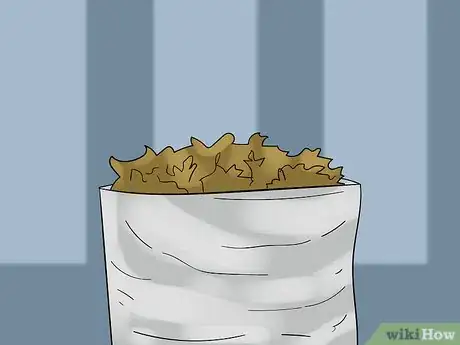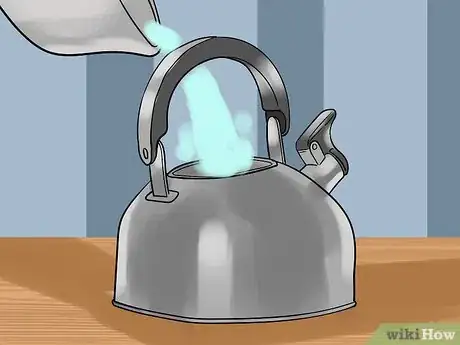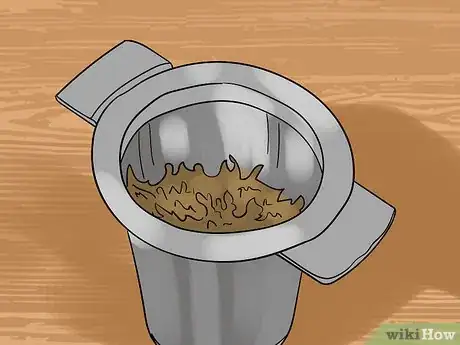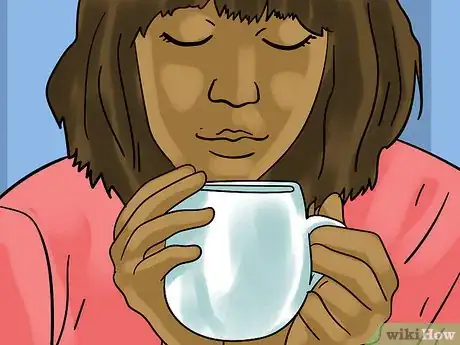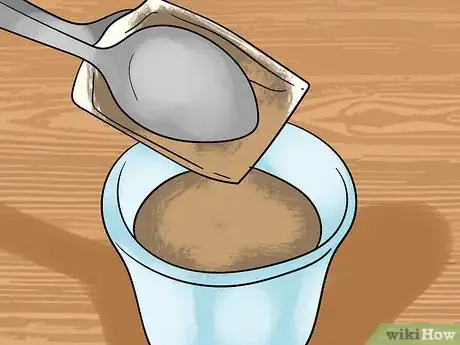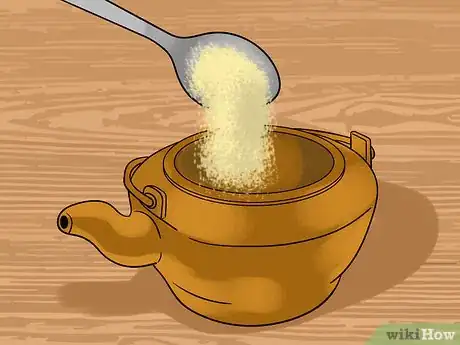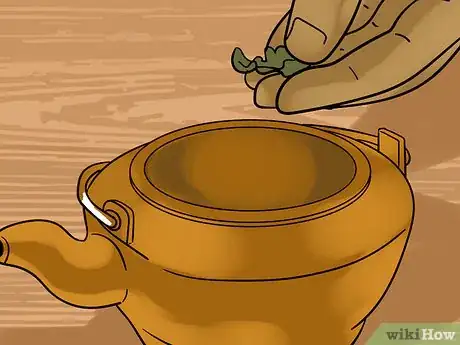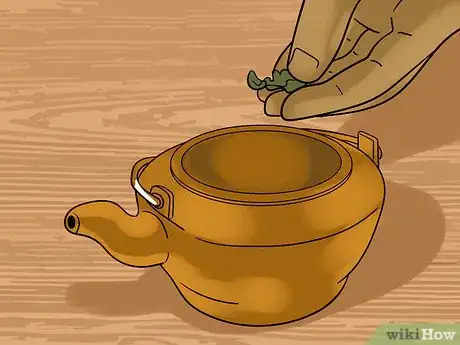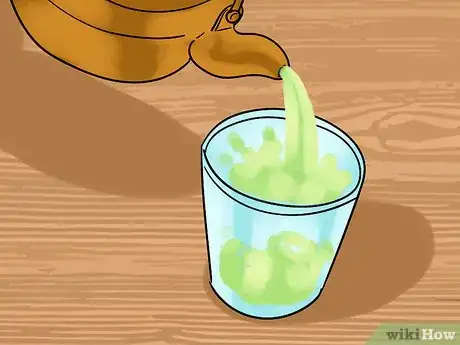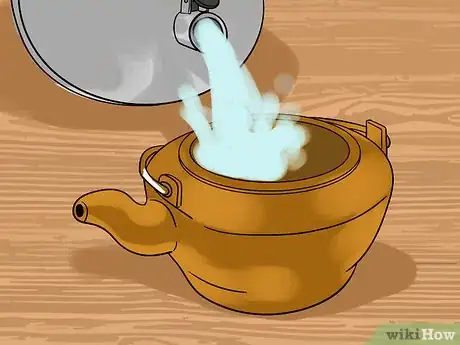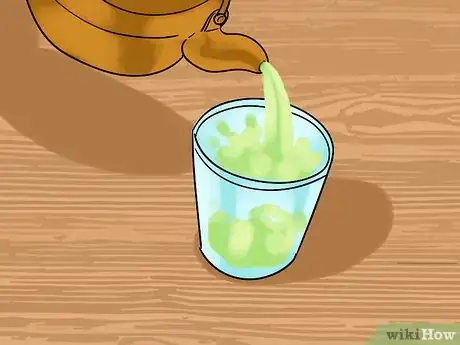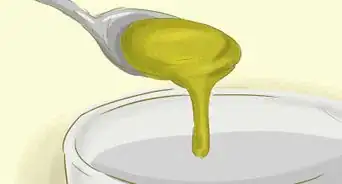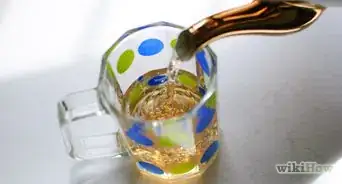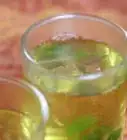This article was co-authored by wikiHow Staff. Our trained team of editors and researchers validate articles for accuracy and comprehensiveness. wikiHow's Content Management Team carefully monitors the work from our editorial staff to ensure that each article is backed by trusted research and meets our high quality standards.
There are 14 references cited in this article, which can be found at the bottom of the page.
This article has been viewed 148,042 times.
Learn more...
Bland and boring tastes can come from stale tea bags, low water temperature, or short steep times. Learn how tea experts brew so you can fix the problems in your own teapot. It often helps to buy higher-quality, loose leaf tea, but this does not have to be expensive or difficult to brew.
Steps
Improving Tea Flavor
-
1Start with whole, loose leaf tea (recommended). The broken up leaves found in teabags may over-steep and turn bitter faster than loose leaf tea.[1] Loose leaf tea tends to create more complex flavors.
- That said it might be a myth that all tea bags contain low-quality tea. As long as you don't let the teabags grow stale, some of them can deliver a tasty cup.[2]
- Most black teabags contain finely crushed tea processed with the "CTC" method (crush, tear, curl). Many tea aficionados prefer "orthodox" tea processing, which has whole leaves or large pieces.[3] When sold in teabags, orthodox tea may also be labeled "full leaf," "pure leaf," or "long leaf".[4]
-
2Choose your water. The type of water you use can have a major effect on taste. If you dislike the taste of your tap water, filter it before heating it for tea. If the tea still tastes funky, try bottled water. Water labeled "alkaline" may be a good choice, but with so many brands of water and types of tea you may need to experiment on your own.[5]
- Distilled water tends to make your tea taste flat and dull.
Advertisement -
3Heat water in a glass or stainless steel kettle. Plastic kettles may leech undesirable flavors into your tea.[6] Most quality teas should recommend an ideal water temperature, but you can use these simple rules in most cases (assuming you are near sea level):
- Black teas are almost always brewed at near-boiling temperatures. Bring to a boil, then let stand for thirty seconds or so before pouring.
- Most green teas brew best at 160–170ºF (70–76ºC), or when a column of steam starts rising from the water.[7]
- Many Japanese green teas and some early spring Chinese green teas are extra delicate and should not be brewed above 160ºF (70ºC). Anything hotter can make these teas very bitter.[8] [9]
-
4Brew in a basket or other large container. Tea leaves develop more complex flavors when they can expand in the water, sometimes as much as five times their original size. If you're using loose leaf tea, don't confine it to a "tea ball" or another small container. Go for stainless steel, cup-shaped brew basket or brew in a teapot with a filtered spout to block the leaves.[10]
- As a rule of thumb, put in 1 tsp (5 mL) tea leaves (or one teabag) for every 6 oz (175 mL) water. Feel free to add more if you're looking for a stronger taste. (Alternatively, try the Eastern style brewing method described below, which uses a higher concentration of leaves.)
-
5Taste your tea as it steeps. If you dislike the flavor of your tea, you may need to give it more time to steep — or you may need to take the leaves out early before they release bitter tannins. Tasting your tea every 30 seconds or so is an easy way to figure out what you prefer. You'll usually end up with good flavors if you follow the guide on the tea label, or use these rules of thumb:[11] [12]
- 3–5 minutes for black tea or oolong
- 3 minutes for Chinese green tea
- About 2 minutes for Japanese green tea
- 1–3 minutes for white tea
- Note — water at a higher temperature extracts flavors much faster.[13] You may need to rely on taste tests if you're eyeballing the temperature.
-
6Steep repeatedly or squeeze the teabag. Most loose leaf teas can stand up to a second or third steep in the same sitting. Pay attention to the flavors, which change subtly on each brew. Teabags lose flavor much faster; just squeeze them into the tea to get the flavors out before drinking your first cup.
-
7Add flavoring if necessary. If you're trying to maximize the flavor of the tea itself, listen to the tea snobs: try to enjoy the tea plain, or add at most a splash of dairy and a small spoonful of sweetener to black tea. That said, if you're just trying to enjoy yourself, add as much as you like. Chai tea has a particularly intense flavor, and you can make it yourself by adding cloves, cardamom, and other spices.
- You can also buy tea that comes pre-flavored. The highest quality teas are rarely sold this way, but that doesn't mean you can't find something you enjoy.
Brewing Tea Eastern-Style
-
1Choose a small brewing vessel. Most tea drinkers in East Asia prepare tea in a way Westerners may not find familiar. Traditionally, the teapot should be quite small: about 3.4–6.8 oz (100–200 mL) for a single serving. There are many traditional Chinese and Japanese tea vessels such as the gaiwan or shiboridashi designed for this purpose.[14]
- For more consistent temperature control, warm the pot first by rinsing it with hot water.[15]
-
2Put in a large amount of loose leaf tea. At a minimum, the tea leaves should cover the bottom of the vessel. It's common to fill it ¼ to ⅓ full with leaves.[16]
-
3Rinse the leaves. Pour a small amount of hot water onto the leaves, then use the lid as a strainer to pour out the water without losing the leaves. Smell the aroma released as the leaves open up.[17]
-
4Steep for about 30 seconds. Right after rinsing, fill the teapot with hot water. Because you're using so many leaves in a small teapot, you do not need to steep as long as usual. After thirty seconds — or even just a few seconds for strong, dark tea — pour the tea into your cup.
- The temperature of the water depends on the type of tea. Read the first section above for more information, or check your tea label.
-
5Steep many more small cups. If you have the time, you can easily spend hours drinking one pot of tea. A high-quality loose leaf should stand up to many infusions. Steep for about 10–30 seconds longer each time, and pay attention to how the flavor changes with each go.[18]
- It helps to have a kettle with good insulation or a warming function, to keep your water at the same temperature.
-
6Try a more casual Eastern method. If you enjoy the more intense, complex flavor of the Eastern brew, but don't have the time to devote to it, try putting the leaves directly in a cup or thermos. Pour on more hot water frequently as you drink, never letting the water level drop below ⅔ of the pot. This gives you an especially strong tea with some of the changing qualities of a traditional brew.[19]
- If your cup has a lid, cover it after the second or third refill to keep in the heat that improves extraction.
- Pour hot water along the edge of the cup to stir the leaves up and mix it with the last infusion.
Community Q&A
-
QuestionWhen making tea bags, should I boil water first or boil water with tea in it?
 Community AnswerBoil water first, add the water to a cup, and put the tea bag in the water. Wait a while for the water to absorb the tea bag's leaves, then enjoy.
Community AnswerBoil water first, add the water to a cup, and put the tea bag in the water. Wait a while for the water to absorb the tea bag's leaves, then enjoy. -
QuestionWhat do I do if I don't have access to loose-leaf tea?
 Community AnswerYou can use teabags. They're also good to use. There's no huge difference if you go for the other way of making tea.
Community AnswerYou can use teabags. They're also good to use. There's no huge difference if you go for the other way of making tea.
Things You'll Need
- Filtered Water
- Quart Container
- Tea
- Kettle
- Extras if desired
References
- ↑ http://www.seriouseats.com/2015/01/tea-for-everyone.html
- ↑ https://www.quora.com/Does-bouncing-your-tea-bag-actually-do-anything-substantial/answer/Matt-Harbowy?srid=CfG
- ↑ http://www.teaclass.com/lesson_0106.html
- ↑ http://www.tealeafjournal.com/whole-leaf-tea.html
- ↑ http://www.seriouseats.com/2014/06/best-water-for-tea-tap-spring-bottled-filtered.html
- ↑ http://www.seriouseats.com/2015/07/tea-brewing-equipment.html
- ↑ https://www.teatrekker.com/steeping-green-tea
- ↑ http://www.seriouseats.com/2015/01/tea-for-everyone.html
- ↑ https://www.teatrekker.com/steeping-green-tea
- ↑ http://www.seriouseats.com/2015/07/tea-brewing-equipment.html
- ↑ http://www.artoftea.com/what-is-tea/recommended-steep-times/
- ↑ http://www.thedailytea.com/taste/beginners-guide-to-green-tea/
- ↑ https://www.quora.com/Does-bouncing-your-tea-bag-actually-do-anything-substantial/answer/Matt-Harbowy?srid=CfG
- ↑ http://theteadetective.com/ChinasGaiwanTeaBowl.html
- ↑ http://drinks.seriouseats.com/2011/01/tea-technique-gaiwan-brewing.html
- ↑ http://www.greenterraceteas.com/blogs/news/9796464-tea-making-western-style-vs-chinese-style
- ↑ http://drinks.seriouseats.com/2011/01/tea-technique-gaiwan-brewing.html
- ↑ http://www.seriouseats.com/2015/01/tea-for-everyone.html
- ↑ http://www.marshaln.com/2010/07/monday-july-19-2010/
- ↑ http://www.seriouseats.com/2015/07/tea-brewing-equipment.html
- ↑ http://www.marshaln.com/tag/yixing/
